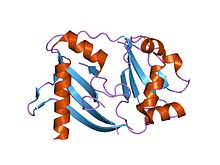CRISPR
| Cascade (CRISPR-associated complex for antiviral defense) |

Structure of crRNA-guided E. coli Cascade complex (Cas, blue) bound to single-stranded DNA (orange).
|
| Identifiers |
| Organism |
Escherichia coli |
| Symbol |
? |
| PDB |
4QYZ |
Clustered regularly interspaced short palindromic repeats (CRISPR, pronounced crisper) are segments of prokaryotic DNA containing short, repetitive base sequences. Each repetition is followed by short segments of spacer DNA from previous exposures to foreign DNA (e.g., a virus or plasmid). Small clusters of cas (CRISPR-associated system) genes are located next to CRISPR sequences.
The CRISPR/Cas system is a prokaryotic immune system that confers resistance to foreign genetic elements such as those present within plasmids and phages that provides a form of acquired immunity. RNA harboring the spacer sequence helps Cas proteins recognize and cut exogenous DNA. Other RNA-guided Cas proteins cut foreign RNA. CRISPRs are found in approximately 40% of sequenced bacterial genomes and 90% of sequenced archaea.
A simple version of the CRISPR/Cas system, CRISPR/Cas9, has been modified to edit genomes. By delivering the Cas9 nuclease complexed with a synthetic guide RNA (gRNA) into a cell, the cell's genome can be cut at a desired location, allowing existing genes to be removed and/or new ones added. The Cas9-gRNA complex corresponds with the CAS III crRNA complex in the above diagram.
CRISPR/Cas genome editing techniques have many potential applications, including medicine and crop seed enhancement. The use of CRISPR/Cas9-gRNA complex for genome editing was the AAAS's choice for breakthrough of the year in 2015.Bioethical concerns have been raised about the prospect of using CRISPR for germline editing.
The discovery of clustered DNA repeats began independently in three parts of the world.
The first description of what would later be called CRISPR was from Osaka University researcher Yoshizumi Ishino in 1987, who accidentally cloned part of a CRISPR together with the iap gene, the target of interest. The organization of the repeats was unusual because repeated sequences are typically arranged consecutively along DNA. The function of the interrupted clustered repeats was not known at the time.
...
Wikipedia



